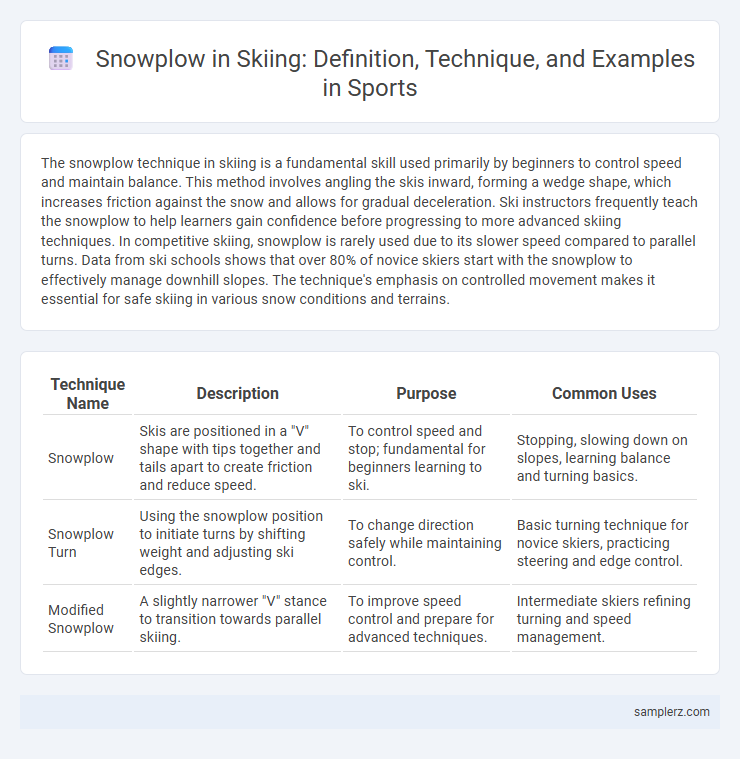The snowplow technique in skiing is a fundamental skill used primarily by beginners to control speed and maintain balance. This method involves angling the skis inward, forming a wedge shape, which increases friction against the snow and allows for gradual deceleration. Ski instructors frequently teach the snowplow to help learners gain confidence before progressing to more advanced skiing techniques. In competitive skiing, snowplow is rarely used due to its slower speed compared to parallel turns. Data from ski schools shows that over 80% of novice skiers start with the snowplow to effectively manage downhill slopes. The technique's emphasis on controlled movement makes it essential for safe skiing in various snow conditions and terrains.
Table of Comparison
| Technique Name | Description | Purpose | Common Uses |
|---|---|---|---|
| Snowplow | Skis are positioned in a "V" shape with tips together and tails apart to create friction and reduce speed. | To control speed and stop; fundamental for beginners learning to ski. | Stopping, slowing down on slopes, learning balance and turning basics. |
| Snowplow Turn | Using the snowplow position to initiate turns by shifting weight and adjusting ski edges. | To change direction safely while maintaining control. | Basic turning technique for novice skiers, practicing steering and edge control. |
| Modified Snowplow | A slightly narrower "V" stance to transition towards parallel skiing. | To improve speed control and prepare for advanced techniques. | Intermediate skiers refining turning and speed management. |
Understanding the Snowplow Technique in Skiing
The snowplow technique in skiing involves angling the ski tips toward each other while keeping the tails apart, creating a wedge shape that helps control speed and maintain balance. This method is essential for beginners as it allows for smooth turns and effective stopping on gentle slopes. Mastering the snowplow builds foundational skills necessary for progressing to parallel skiing and more advanced techniques.
Step-by-Step Guide to Performing the Snowplow
Begin the snowplow by positioning your skis in a wedge shape, tips together and tails apart, to create controlled friction on the snow. Gradually apply pressure on the inner edges of your skis while bending your knees slightly to maintain balance and slow down effectively. Keep your upper body facing downhill and use gentle steering movements to navigate turns with confidence.
Key Benefits of Mastering the Snowplow for Beginners
Mastering the snowplow technique in skiing enhances beginners' control and stability on slopes, crucial for safe navigation and speed management. This foundational skill allows skiers to effectively slow down or come to a complete stop, reducing the risk of falls and injuries. Developing confidence through snowplow control accelerates progression to more advanced skiing techniques and enjoyable mountain experiences.
Common Mistakes When Learning the Snowplow
One common mistake when learning the snowplow in skiing is placing the skis too close together, which reduces stability and control. Novice skiers often lean back instead of forward, causing loss of balance and difficulty in steering. Incorrectly angling the skis can also prevent effective speed control, leading to unsafe or inefficient stops.
Snowplow vs. Parallel Skiing: Key Differences
Snowplow skiing involves positioning the skis in a V-shape with tips close together and tails apart, which helps beginners control speed and make easy turns. Parallel skiing, favored by advanced skiers, requires keeping skis parallel throughout the turn, allowing for greater speed and smoother, more precise movements. The key difference lies in stability and control; snowplow offers increased stability at lower speeds while parallel skiing emphasizes efficiency and agility on varied terrain.
How the Snowplow Improves Skiing Safety
The snowplow technique in skiing enhances safety by providing greater control over speed and direction, which reduces the risk of collisions on slopes. By angling the skis inward and applying pressure, skiers can effectively slow down and stop, making it ideal for beginners to navigate challenging terrains. This method also improves balance and stability, minimizing falls and injuries during downhill skiing.
Best Drills to Practice the Snowplow Technique
Effective drills to master the snowplow technique in skiing include the "Pizza Slide," where beginners form a wedge shape with their skis to control speed and direction. The "Snowplow Turn" drill helps skiers practice making gradual turns by applying pressure on the inside edges of the skis. Repeatedly performing these exercises on gentle slopes builds confidence and improves balance, essential for progressing to more advanced skiing skills.
When to Use the Snowplow on the Slopes
The snowplow technique in skiing is most effective for beginners learning to control speed and make gentle turns on gentle slopes. It is especially useful when navigating crowded or icy conditions, as it provides increased stability and traction. Skiers should use the snowplow to maintain balance and gradually reduce speed before progressing to advanced parallel turns.
Snowplow Turns: Tips for Better Control and Steering
Snowplow turns in skiing involve angling the skis inward to create a wedge shape, allowing beginners to slow down and control their speed effectively. To improve steering, apply gentle pressure on the inside edges of the skis while leaning slightly forward to maintain balance and stability. Practicing consistent weight shifts and smooth edge engagement enhances precision and confidence on varied snow conditions.
Expert Advice: Transitioning Beyond the Snowplow
Experts recommend gradually shifting weight to the downhill ski and increasing edge engagement to transition beyond the snowplow technique in skiing. Emphasizing parallel ski positioning and balanced body posture enhances control and speed on more advanced slopes. Consistent practice under professional supervision accelerates the development of smooth, efficient turns required for intermediate and expert levels.

example of snowplow in skiing Infographic
 samplerz.com
samplerz.com